Bayer Leverkusen hosted Atletico Madrid for matchday four of the UEFA Champions League. Peter Bosz’s Leverkusen were hoping to gain their first points of the group stage, while Diego Simeone’s Atlético were aiming to surmount Juventus at the top of the group. Leverkusen finished the game as 2-1 winners over the visitors, taking the lead via an own goal before extending it soon after. Atlético replied late on but there was not enough time for them to score an equaliser.
This tactical analysis will investigate how Leverkusen were able to beat the team from Madrid via an analysis of multiple match elements. The analysis will include information on tactics with offensive, defensive and transitional components of play from each team as well as other key match events.
Line-Ups
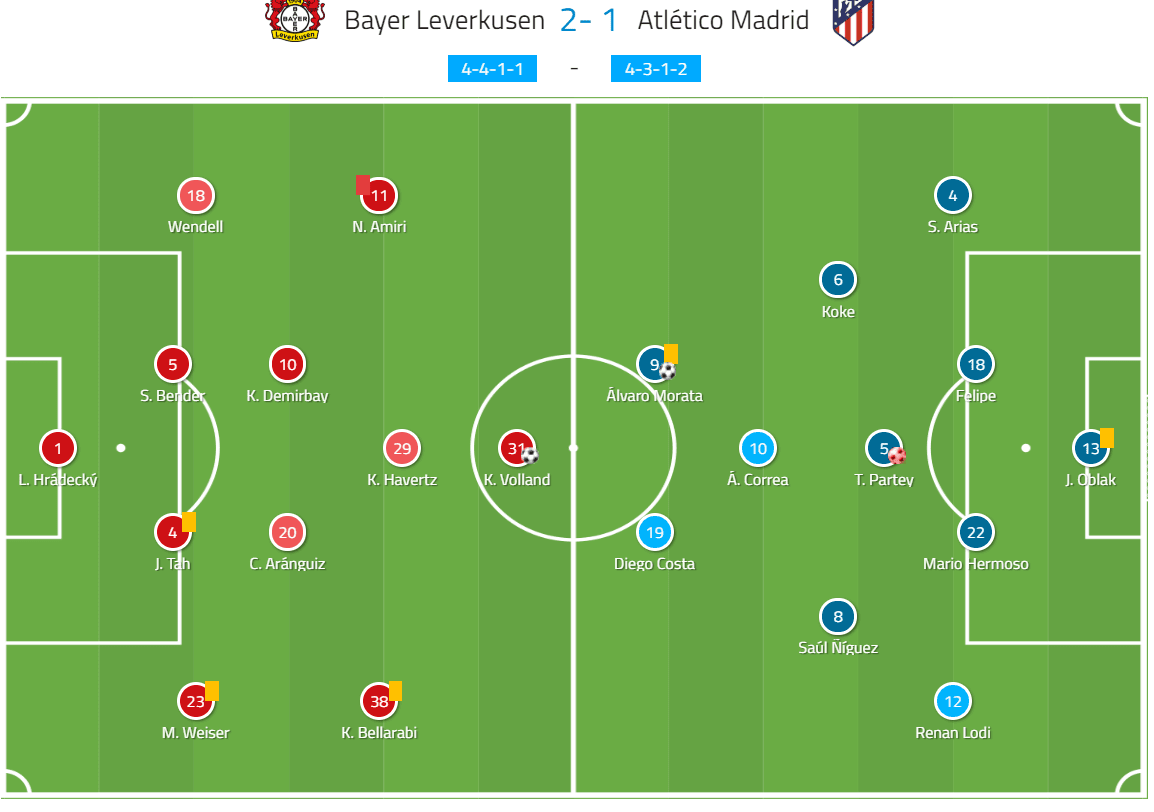
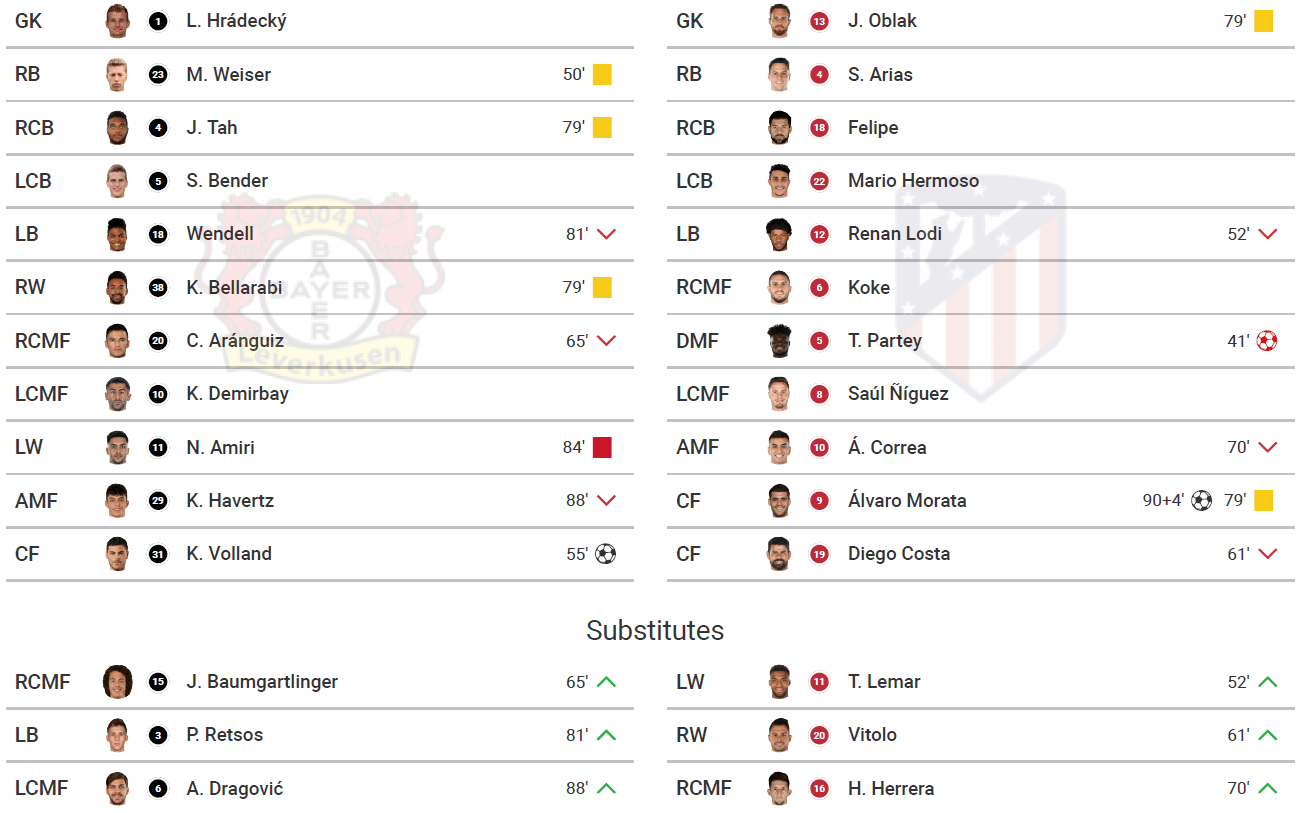
Within the match, Leverkusen lined up with a 4-4-1-1, while Atlético Madrid operated using a 4-4-2 diamond. João Félix was the main absentee for Atlético going forward, as their record signing is currently sidelined with an ankle injury. In a defensive sense, Atlético were also missing their two first-choice centre-backs in Stefan Savić and José Giménez. For Leverkusen, Lars Bender was the most notable absentee in an otherwise fully fit squad.
Average Formations
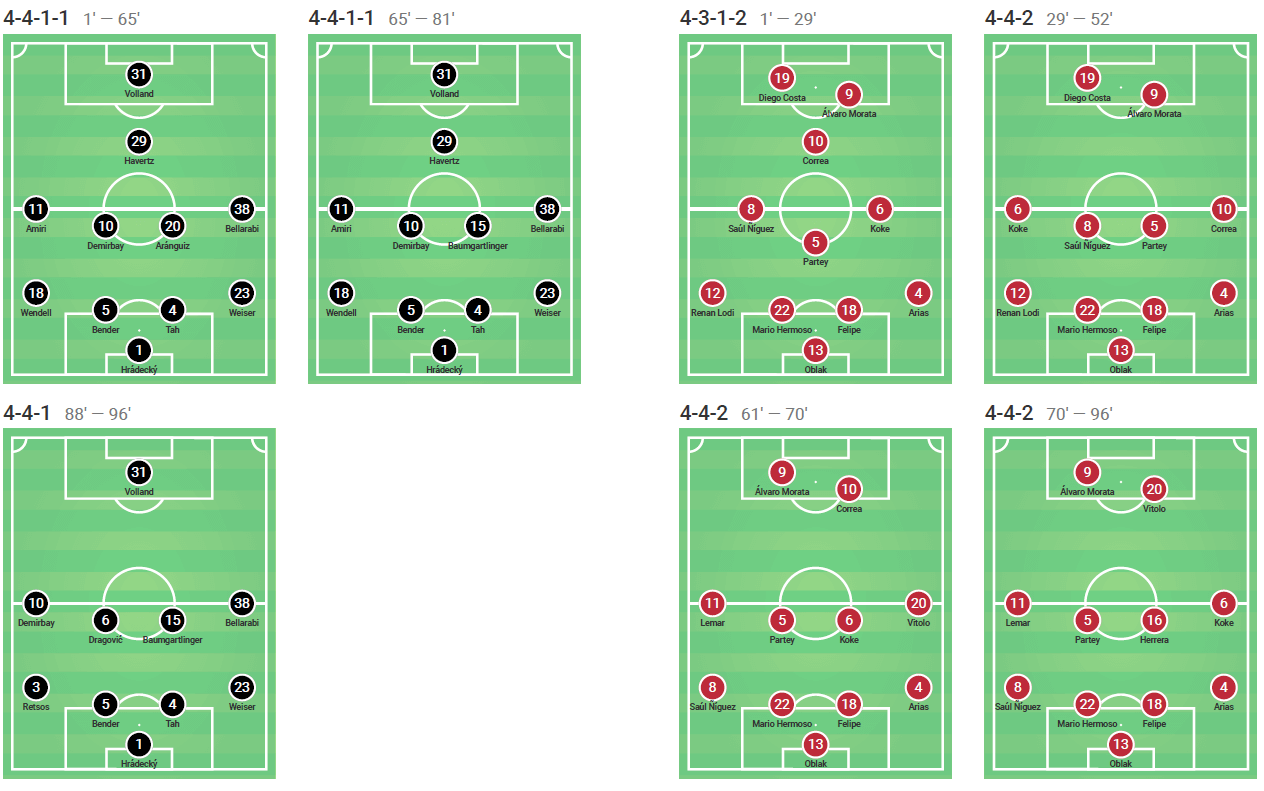
Despite the initial starting formations being those previously discussed, adaptations to the formation and playing personnel did occur throughout the clash. For Leverkusen, they stuck with their main shape which was clearly working during the match, given they were 2-0 up after 55 minutes, with Atlético only replying late in the 94th minute. However, Leverkusen did lose Nadiem Amiri to a straight red card in the 84th minute, causing them to lose their number ‘10’ creator and instead just operate with two banks of four behind the striker, Kevin Volland.
Atlético made more structural changes. After their diamond failed to have a large impact in the first 30 minutes, the team swapped to their more generic 4-4-2 formation, with Ángel Correa moving from the number ’10’ position to the right of midfield. Shortly before Leverkusen scored the 2-0, Simeone decided to shake things up by bringing on left midfielder, Thomas Lemar for left-back, Renan Lodi, and moved midfielder, Saúl Ñíguez, to the left-back slot to fit Lemar in and offer enhanced ball playing and offensive style from the left-back position.
In regards to average positioning, the key point of analysis to note is that Leverkusen played deeper than their opposition, with seven of their ten outfield players averaging their position behind the halfway line. For Atlético, only three of their players were positioned within their defensive half. Therefore, in transition, Leverkusen’s players had more space to run in behind the Atlético line while protecting themselves better in the process.
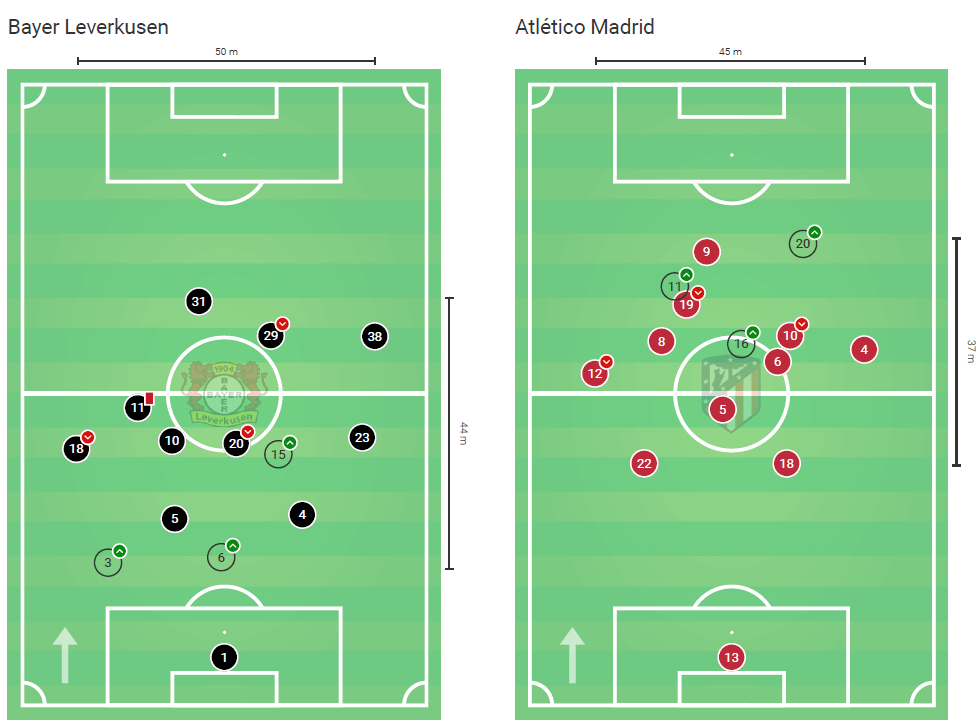
Match Stats
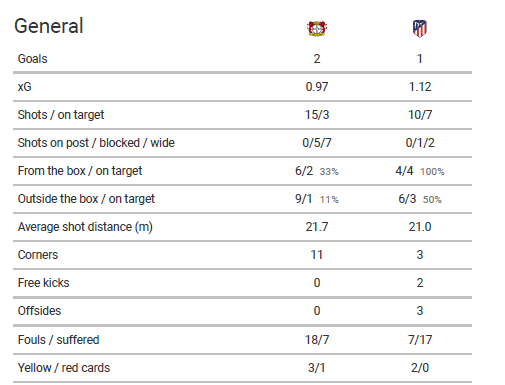
On the face of it, the match looks fairly even. Leverkusen were slightly outscored in terms of xG, with both teams close to expecting one goal each. Leverkusen’s first goal was an own goal by Thomas Partey which appears to be the main difference between the teams as opposed to one team dominating in terms of chance creation.
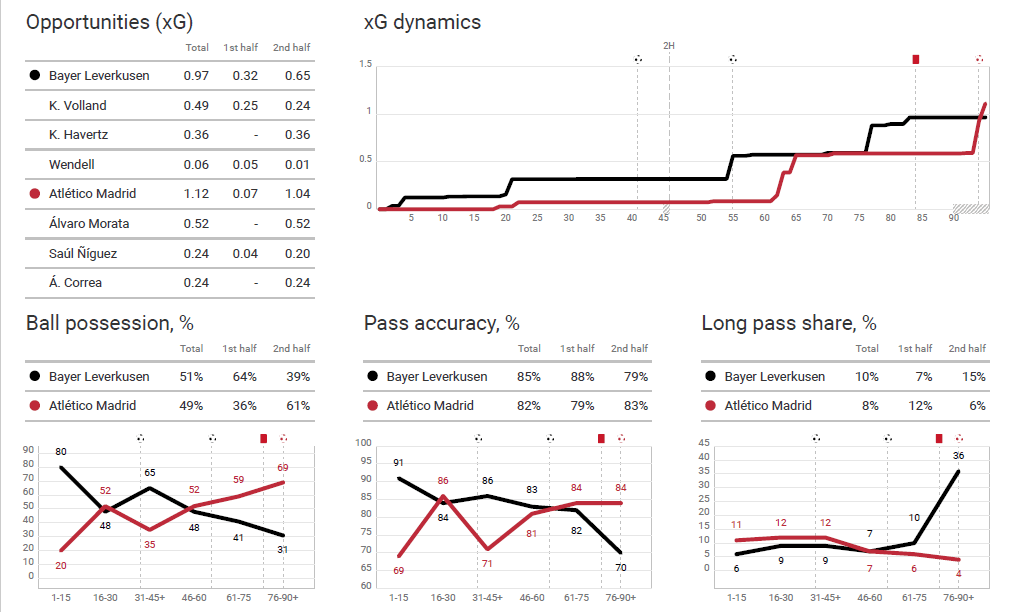
Possession was equal although there was a big swing from the first to the second half. This is potentially due to the structure of the teams and the impact of the goals. Leverkusen dominated possession in the first half as Atlético struggled to dominate whilst in a diamond formation. In the second half, Atlético dominated possession, presumably due to the team going two-goals down in the second half and Leverkusen allowing Atlético to keep the ball in favour of maintaining defensive structure before countering when needed. Within the first half, Leverkusen still tried to counter and were successful in doing so, but also remained patient with the ball when they had it rather than committing too many men forward, hence the first half possession dominance.
The stats suggest that Leverkusen had joy in wide areas against Atlético, hence their 11 corners compared to the three for Atlético. This was due to Atlético’s early use of the diamond, the swift counters of Leverkusen, the direct nature of Karim Bellararbi and a poor team press and reluctance to get goal side from Atlético players. These concepts will be discussed further on.
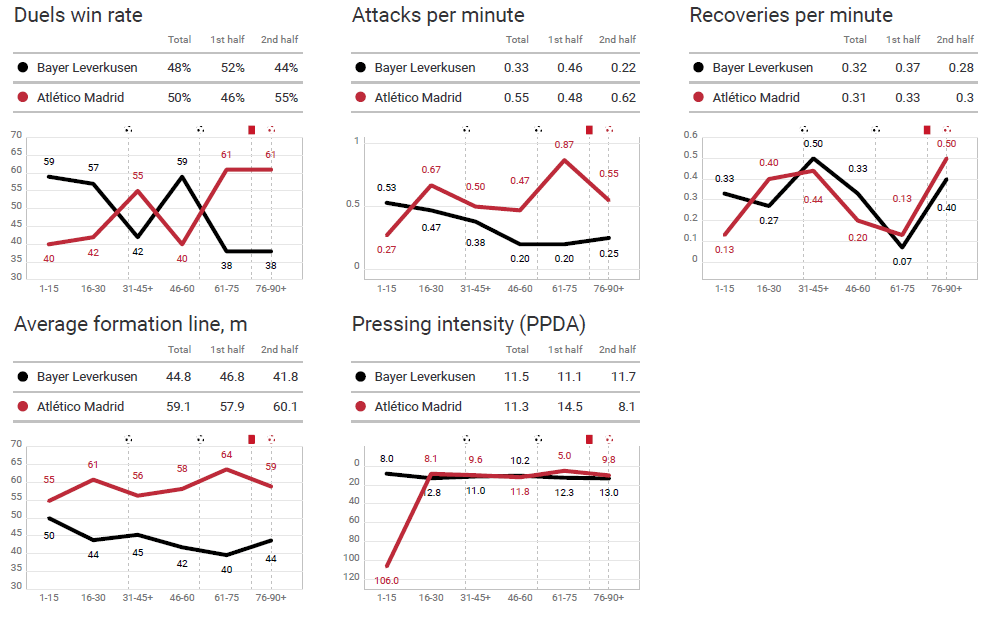
Atlético were the more consistent attackers, however, Leverkusen were effective in nullifying most attacks and counter-attacking with regularity. Both teams pressed in a similar fashion when it came to intensity.
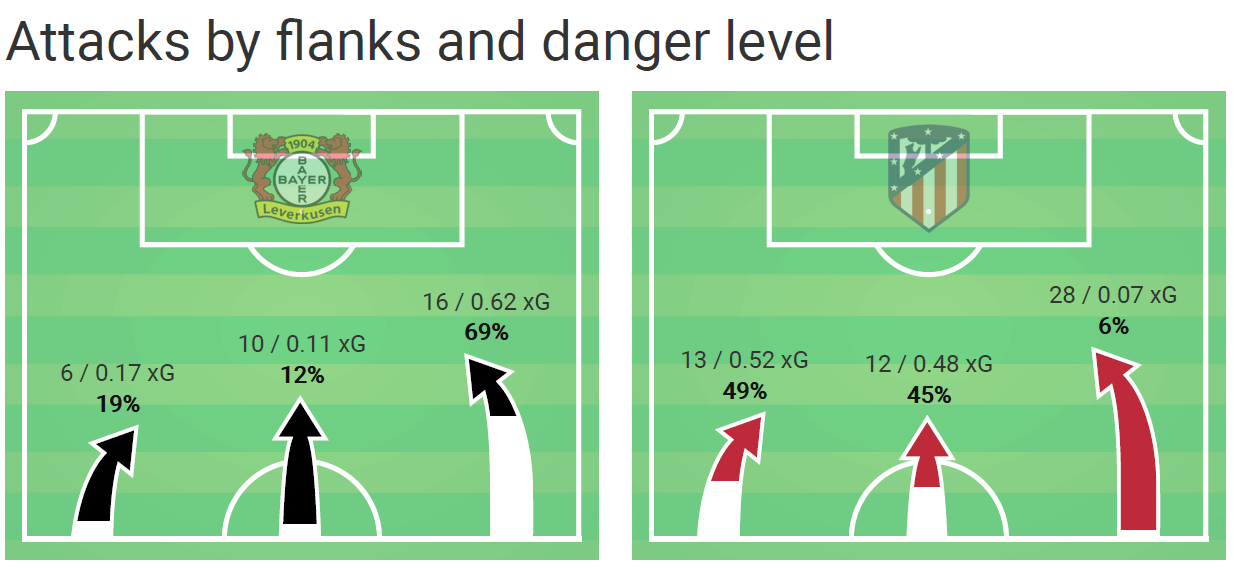
In the attack direction chart, you can see that Leverkusen experienced success down the flanks, specifically the right flank where Bellararbi was playing. Atlético also tried to make inroads down the right with a high frequency of attacks, but, higher quality chances were created through the centre and left as opposed to the right flank. Bellararbi had success against Lodi. After the left-back was substituted, presumably due to tactical adaptations for Atlético, but perhaps to also try and match up Saúl against Bellararbi, the winger for Leverkusen manipulated his man, found space to cross and assisted the second goal.
All about the flanks for Bayer Leverkusen
While in possession, Leverkusen targeted the wings with their play. This was mainly due to the impressive Bellararbi playing on the right flank. The player looked direct throughout the match and posted impressive dribbling and crossing statistics, as well as an assist for Volland. The player’s ball-carrying skills were impressive, even more so in the transition when he had space to exploit.
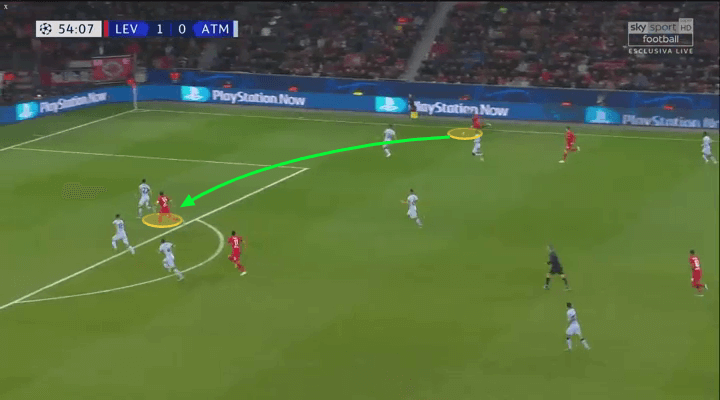
In possession, Leverkusen were much more patient when compared to their transitional attacks. Despite being the home side, they rarely over-committed with too many players streaming forward and instead, remained patient in the build-up. Because Leverkusen were patient in their build-up, and naturally sat deeper than their opponents, they were aiming to invite pressure from an unusually disjointed Atlético before progressing quickly.
Atlético Madrid, what transition?
Atlético’s offensive transitions within the match were largely nullified within the match. The Spanish side rarely won the ball back while Leverkusen were committed forward, therefore, when transitions were attempted, Leverkusen were generally comfortable at delaying the attack with sufficient numbers back.
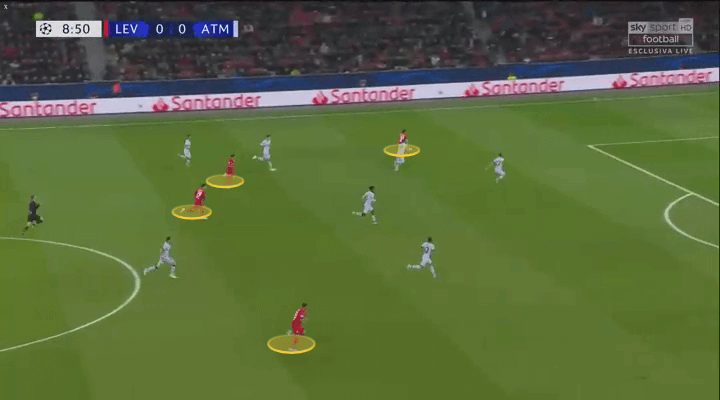
That being said, Atlético did occasionally position their players in effective positions to act as a trap for any mistakes Leverkusen made when playing out from the back. An overhit pass from the Leverkusen goalkeeper resulted in a quick attack by Atlético and resulted in their second-best chance of the match in terms of xG value, second only to their late goal.
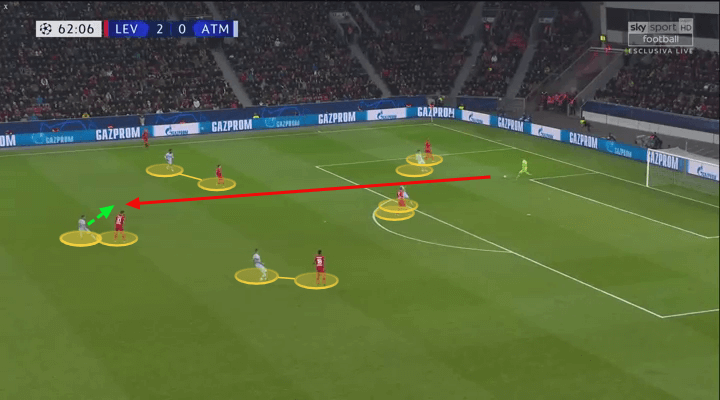
For their goal, Atlético did win the ball back high on the flank, but they recycled the ball back as if the situation was a normal sequence of possession, so while a transition, Leverkusen had time to get back in shape, but with only three passes from winning the ball back to scoring, it could be deemed a successful offensive transition.
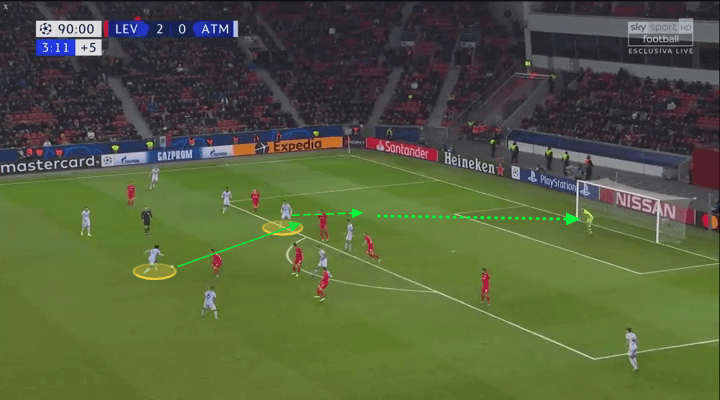
Atlético run out of ideas in possession
In possession, Atlético Madrid did not have much joy against a well-organised Leverkusen block. Leverkusen nullified their progression attempts by using a structure with two banks, but with players also occupying the space between them. Santiago Arias saw much of the ball and Atlético attempted to progress down the right flank for the majority of their attacks, as seen by the attacking zone chart. However, Atlético were unable to get Arias into advanced positions beyond the defensive line or full-back, and while Arias made six crosses, the joint highest number along with Bellararbi, with a higher success rate, such crosses did not result in any quality chances.
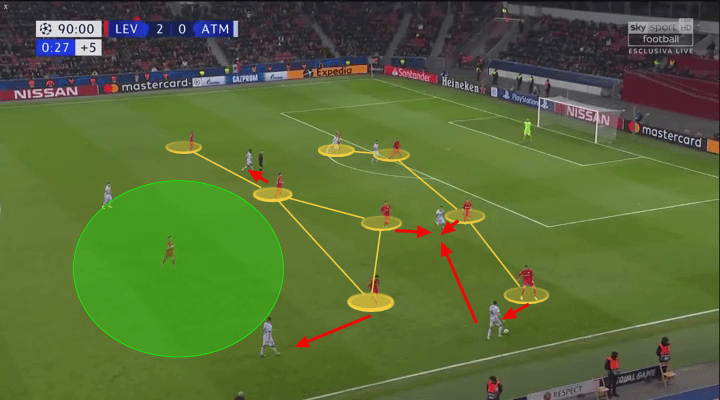
Leverkusen’s swift transition as the counter-attacking team
Atlético seemed out of sorts with their pressing against Leverkusen. The visitors did not press as a team and their offensive players lacked the intensity to recover behind the ball after losing it or after the press was bypassed. On multiple occasions, one player pressed, but the chain did not continue, leaving Leverkusen players free to play to spare men. This happened on numerous occasions, allowing Leverkusen to attack the space directly, usually on the flanks. Such danger was exaggerated when Atlético were playing their diamond formation.
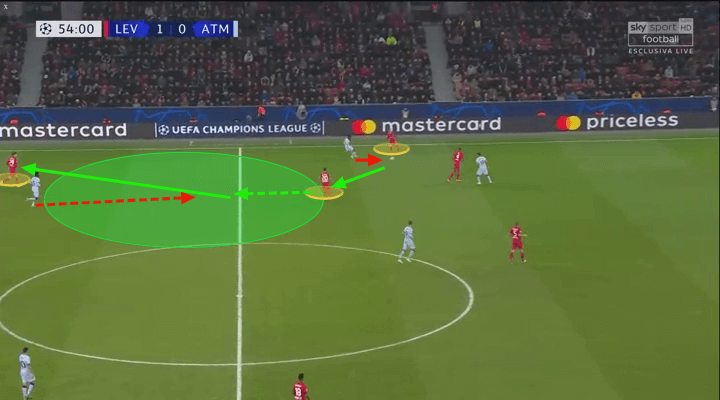
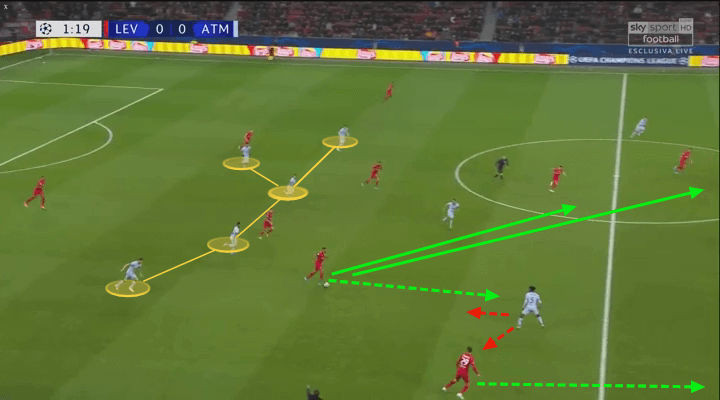
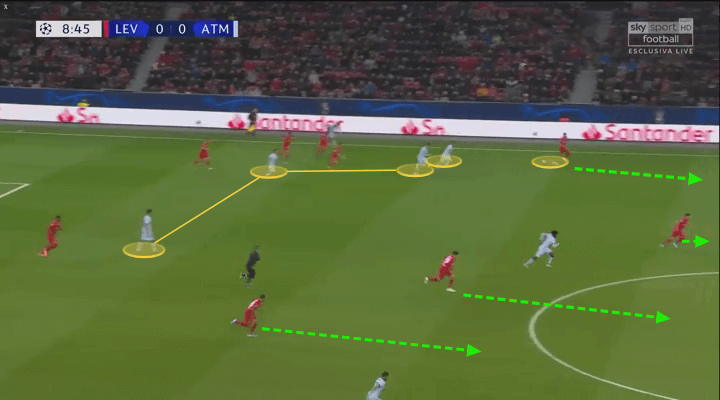
When the forwards and advanced midfielders progressed forwards they were slow to recover behind the ball when Leverkusen won possession. Leverkusen spotted this and made the most of their quick offensive players, again, without over committing, they created numerous 1v1’s for individuals and numerical similarities or overloads in a team sense, rather than facing a structured block of players. This helped Leverkusen to progress quickly in transition and create chances or pitch dominance via corners after flank play.
Dangerous set-piece tactics
Both teams created chances from set-pieces, with varied tactics having offensive success. Leverkusen organised all of their offensive players within the six-yard box and this dragged the defenders back and overloaded the box. An in-swinging delivery was then utilised with pace and curve in towards the goal with added bodies around the goalkeeper. More than anything else, this caused confusion and Atlético simply had no space to go and attack the ball to clear.
This created the opening goal as Jan Oblak saved at the near post but could not clear and in the second phase, Partey attempted to head clear but caught the ball in the wrong spot and headed into his own net.
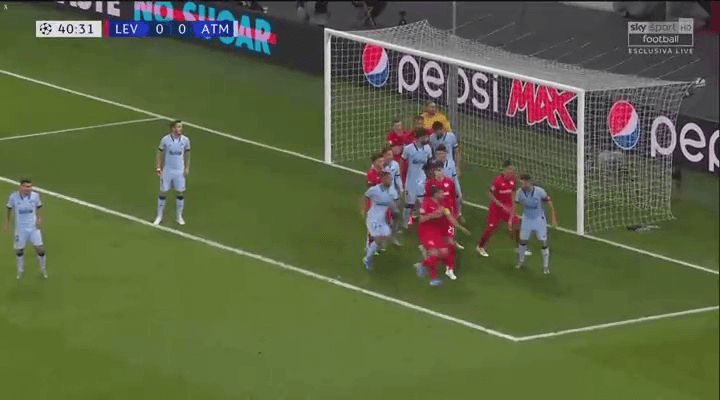
For Atlético, they created their chances from corners via a varied approach. The first successful approach was an out-swinging corner with numerous players pulling back before running towards the ball to lose their markers.
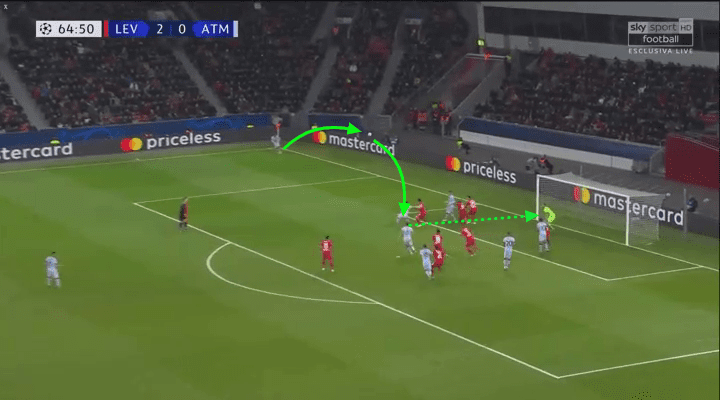
The second routine involved a quick short corner, pass to the edge of the box and a shot from outside the box. It did not specifically create a high-value chance, but, a clear shot on goal was achieved.
Conclusion
Overall, the performances from both teams were unexpected based on previous displays this season. Atlético were poor defensively, mainly due to their poor press, team cohesion and willingness to retain shape. Leverkusen were happy to sit in when Atlético attacked but capitalised on their poor counter-press and uninventive attacks to win the ball and play through the opposition lines easily with effective wing play. Set-pieces were a source of success for both teams, but, likewise to open play, Leverkusen capitalised on the chances they earned from their corners. Atlético left it too late to create and finish a clear chance to get back into the match.
——————————————————————————————————

If you love tactical analysis, then you’ll love the digital magazines from totalfootballanalysis.com – a guaranteed 100+ pages of pure tactical analysis covering topics from the Premier League, Serie A, La Liga, Bundesliga and many, many more. Buy your copy of the November issue for just ₤4.99 here





Comments